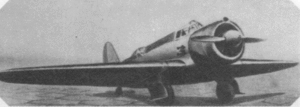- Kharkov KhAI-5
-
KhAI-5 / R-10 / PS-5 Role Reconnaissance and light bomber monoplane National origin Soviet Union Manufacturer Kharkiv Aviation Institute Designer Iosif Grigorevich Nyeman First flight June 1936 Primary user Soviet Air Force Number built 500+ The Kharkov R-10 (KhAI-5) was a Soviet reconnaissance and light bomber aircraft, designed in the mid 1930s in the Kharkiv Aviation Institute (KhAI, HAI - in Russian: ХАИ), under the direction of Iosif Grigorevich Nyeman.
Contents
Development
The first prototype of the plane, with a factory designation KhAI-5 (ХАИ-5), flew in June 1936. Despite a lower performance, the aircraft won a contest against another reconnaissance plane design, the Kotcherigin R-9, and was accepted for a production with the military designation R-10 ('R' meant a purpose - razvyedchik - reconnaissance). It was quite a modern design at that time. 493 R-10s had been manufactured in Kharkiv and Saratov aviation plants by early 1940. The first series showed some teething problems, and because of these I. Neman was arrested by the NKVD on December 11, 1938 under false accusation of sabotage and espionage.
In 1938, a variant KhAI-5bis was tested - fitted with an M-25E engine, it developed a speed of 425 km/h (264 mph). In 1938, the KhAI-52 ground attack aircraft, based on the R-10, was also developed. It was fitted with an M-63 670 kW (900 hp) engine and armed with seven machine guns and 400 kg (882 lb) bombs. A production run of an experimental series of 10 aircraft was prepared, but it was cancelled after I. Neman had been arrested.
Some production R-10s were fitted with more powerful Tumansky M-88, Shvetsov M-62 and M-63 engines. Over 60 aircraft, withdrawn from the Air Force, were used from 1940 as mail carriers by Aeroflot, under the designation PS-5 (Russian: ПС-5), with 3 passenger seats.
Combat use
The aircraft entered service in the Soviet Air Force in 1937, replacing some Polikarpov R-5s. R-10s were first used in combat in the Soviet-Japanese Battle of Khalkhin Gol in 1939. Then, they were used in the initial stage of the World War II, starting with use against Poland in the Invasion of Poland (without combat encounters) and against Finland in the Winter War (1939-1940). R-10s were next used in the first period of the German-Soviet war, following the German attack on June 22, 1941. By this time, they were outdated and suffered heavy losses, as did the rest of the Soviet Air Force. Many planes were destroyed on airfields. They were used as close reconnaissance aircraft, and, in need, also as light attack bombers. Later many were used as night bombers, to avoid losses in encounters with fighters. The remaining R-10s were withdrawn from combat service in 1943 (two Finnish pilots claimed shooting R-10 in 1944).
Description
The aircraft was conventional in layout, with low, plywood-covered wooden wings. The fuselage was of semi-monocoque construction. The undercarriage retracted into the wings. The crew consisted of two: a pilot and an observer-rear gunner in separate compartments; the observer sat in a turret with one machine gun. In the observer compartment's floor there was an AFA-13 camera for reconnaissance duties. Between the crew compartments there were fuel tanks and a vertical bomb bay. The maximum bomb load was 300 kg/661 lb (6 × 50 kg/110 lb or 10 × 25 kg/55 lb). The plane was powered initially by the M-25A, later M-25V radial engine power: 540 kW (730 hp). The two-blade propeller was made of metal.
Operators
- Military Operators
 Soviet Union
Soviet Union
- Soviet Air Force
- Civil Operators
 Soviet Union
Soviet Union
Variants
- R-10 - Production version of KhAI-5
- KhAI-5bis - Improved R-10/KhAI-5 (a.k.a. KhAI-51), one example flown early 1939.
- KhAI-52 - Production version of KhAI-51. Ten ordered but production halted with the arrest of I.Nyeman.
Specifications
Data from[citation needed]
General characteristics
- Crew: Two (pilot and observer)
- Length: 9.40 m (30 ft 10 in)
- Wingspan: 12.20 m (40 ft 0 in)
- Height: 3.80 m (12 ft 6 in)
- Wing area: 26.8 m² (288.3 ft²)
- Empty weight: 2,197 kg (4,833 lb)
- Loaded weight: 2,877 kg (6,329 lb)
- Powerplant: 1 × Shvetsov M-25 radial engine, 545 kW (730 hp)
Performance
- Maximum speed: 388 km/h (210 kn, 240 mph)
- Range: 1,300 km (702 nmi, 802 mi)
- Service ceiling: 6,700 m (21,982 ft)
- Rate of climb: 417 m/min (1,368 ft/min)
Armament
- Guns:
- 2 × fixed, forward-firing 7.62 mm ShKAS machine guns in wings (450 rounds)
- 1 × 7.62 mm ShKAS machine gun in a rear turret (600 rounds)
- Bombs: 300 kg (661 lb) of bombs
See also
- Related development
- Kharkov KhAI-5
- Kharkov KhAI-6
- Kharkov KhAI-51
- Kharkov KhAI-52
- Aircraft of comparable role, configuration and era
- Heinkel He 70
- PZL.23 Karaś
- DAR-10
- Vultee V-11
- Northrop Delta
- Related lists
External Links
- "Неман Р-10 (ХАИ-5)" (in russian). Уголок неба. http://www.airwar.ru. http://www.airwar.ru/enc/spyww2/r10.html. Retrieved 27 February 2011.
Aircraft designed by the Kharkov Aviation Institute Soviet reconnaissance aircraft designations R (Razvyedchik - "Reconnaissance") Soviet airliner designations Lists relating to aviation General Aircraft (manufacturers) · Aircraft engines (manufacturers) · Airlines (defunct) · Airports · Civil authorities · Museums · Registration prefixes · Rotorcraft (manufacturers) · TimelineMilitary Accidents/incidents Records Categories:- Soviet bomber aircraft 1930–1939
- Soviet military reconnaissance aircraft 1930–1939
- World War II Soviet medium bombers
- World War II Soviet reconnaissance aircraft
- KhAI aircraft
Wikimedia Foundation. 2010.

